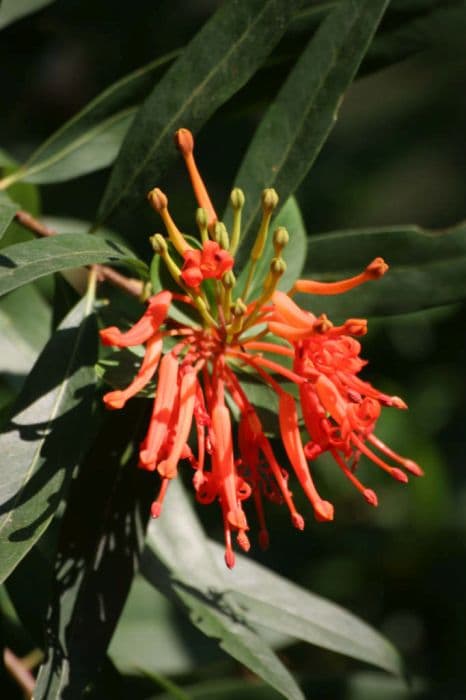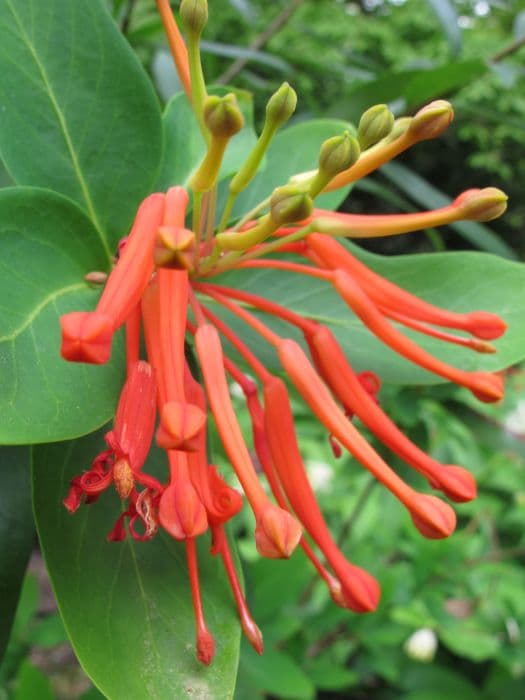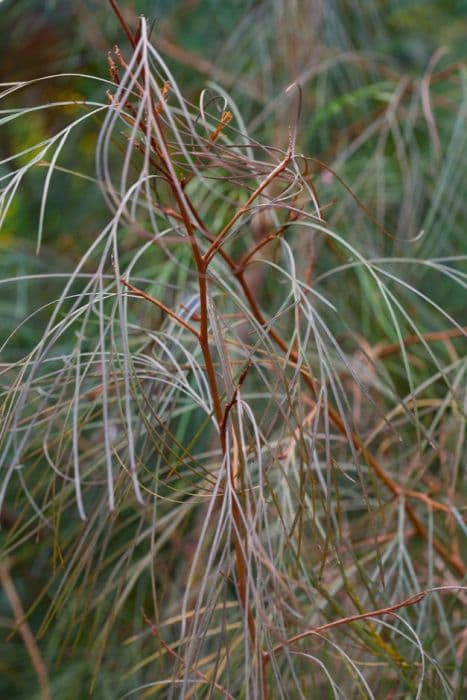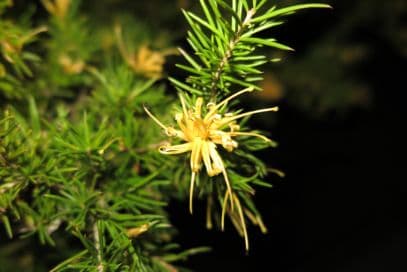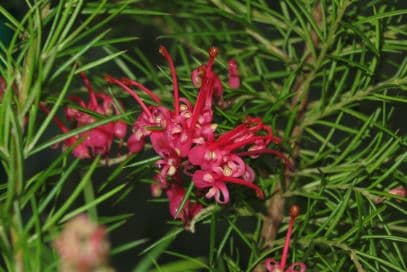Silky oak Grevillea robusta

ABOUT
The plant known as the Silky Oak has an appearance that is distinctive and elegant. This plant is characterized by its fern-like leaves that are feathery and dark green in color. Each leaf is divided into numerous narrow leaflets that create a delicate lacy pattern. The overall shape of the foliage can give the plant a graceful and soft texture despite its sizeable structure. In addition to its leaves, the Silky Oak is celebrated for its flamboyant flowers. The flowers are usually a bright orange or golden-yellow shade, adding a splash of color that contrasts beautifully with its green foliage. These flowers are arranged in toothbrush-like clusters, each bloom slender and curved, resembling the shape of a spider. This distinctive flowering style provides not only a visual feast but also attracts a host of pollinators such as birds and bees. The bark of the plant is another notable feature, often showing a rough texture and a gray to brownish hue. Over time, the bark may fissure, adding character to the plant's appearance. The overall look of the Silky Oak is one of rugged elegance, combining feathery foliage with boldly colored flowers and textured bark to create an aesthetically pleasing presence in the landscape. Despite not discussing its exact size, it is worth noting that the Silky Oak has a strong and well-structured form. Its branching pattern tends to be upward and outward, giving the plant a robust and spreading appearance that adds to its visual impact.
About this plant
 Names
NamesSynonyms
Silk Oak, Southern Silky Oak, Silky Oak, Australian Silver Oak, Silver Oak.
Common names
Grevillea robusta A.Cunn.
 Toxicity
ToxicityTo humans
The Silky oak can be toxic to humans if ingested, although poisoning is relatively uncommon. Contact with the plant can sometimes cause skin irritation due to its fine hairs. If any parts of the Silky oak, particularly the flowers or seed pods, are ingested, they may cause gastrointestinal irritation, leading to symptoms such as nausea, vomiting, and diarrhea. It's advisable to seek medical attention if any part of the plant has been consumed or if a skin reaction develops after contact.
To pets
The Silky oak may also pose a toxicity risk to pets if ingested. Similar to humans, consumption of the plant can lead to gastrointestinal irritation, resulting in symptoms such as vomiting and diarrhea in animals. If a pet ingests any part of the Silky oak, it is important to contact a veterinarian promptly. Additionally, the fine hairs of the plant can cause skin irritation in pets, so it's best to keep animals away from the plant to prevent any adverse reactions.
 Characteristics
CharacteristicsLife cycle
Perennials
Foliage type
Evergreen
Color of leaves
Green
Flower color
Orange
Height
98 feet [30 meters]
Spread
49 feet [15 meters]
Plant type
Tree
Hardiness zones
9
Native area
Australia
Benefits
 General Benefits
General Benefits- Ornamental Appeal: Grevillea robusta, commonly known as the silky oak, has an attractive fern-like foliage and brilliant orange flowers that add aesthetic value to landscapes.
- Shade Provider: Its fast-growing, dense canopy offers excellent shade in gardens and parks.
- Erosion Control: With its deep root system, the silky oak helps stabilize the soil and prevent erosion.
- Wildlife Attraction: The nectar-rich flowers attract birds, bees, and other pollinators, supporting biodiversity.
- Timber Production: The wood of Grevillea robusta is valued for its use in making furniture, paneling, and veneers.
- Drought Resistance: As a drought-tolerant plant, it is suitable for xeriscaping and arid climates, requiring minimal water once established.
- Windbreak: Its height and structure make it effective as a windbreak, protecting against soil desiccation and damage to other plants.
- Fast Growth: The silky oak grows quickly, providing benefits within a short period after planting.
 Medical Properties
Medical Properties- Astringent: The bark of Grevillea robusta, commonly known as the Silky Oak, is considered to have astringent properties.
- Antiseptic: It has been reported that the tree’s bark and leaves may have antiseptic qualities.
 Air-purifying Qualities
Air-purifying QualitiesThis plant is not specifically known for air purifying qualities.
 Other Uses
Other Uses- Grevillea robusta serves as a natural windbreak, with its fast-growing and tall stature providing protection for crops and soil from strong winds.
- It's used as a shade tree in coffee plantations, as it provides a suitable environment for coffee plants to thrive under its canopy.
- The tree produces nectar-rich flowers, which are an excellent food source for bees and help in the pollination of local crops.
- In agroforestry systems, it plays a role in nitrogen fixing, which improves soil fertility and benefits surrounding plant life.
- The wood of Grevillea robusta is used for making musical instruments like guitars, for its resonant qualities and fine grain.
- The leaves and flowers are sometimes used as a mulch or compost material, as they decompose and enrich the soil with nutrients.
- The wood can be crafted into quality furniture and cabinetry due to its durability and attractive appearance.
- Artists use the wood to create sculptures and ornamental pieces because of its workability and fine texture.
- An ornamental plant in gardens due to its vibrant flowers and attractive feathery foliage, which add aesthetic value to landscapes.
- The tree is utilized as a tool for education in botany and horticulture studies, providing a living example for students to learn about the growth and care of trees.
Interesting Facts
 Feng Shui
Feng ShuiThe Australian Silver Oak is not used in Feng Shui practice.
 Zodiac Sign Compitability
Zodiac Sign CompitabilityThe Australian Silver Oak is not used in astrology practice.
 Plant Symbolism
Plant Symbolism- Resilience: The Silky Oak, native to the coastal rainforests of Australia, is known for its robust nature, thriving even in poor soil conditions, symbolizing the ability to endure and flourish despite challenges.
- Boldness: With its striking orange to gold flowers, the Silky Oak represents a bold and unmistakable presence, much like individuals who are not afraid to stand out or take risks.
- Protection: The tree's dense foliage gives shelter to birds and small animals, representing a symbol of protection and a safe haven.
- Adaptability: The Silky Oak can adapt to various climates and environments, symbolizing versatility and the capability to adjust to changing circumstances.
 Water
WaterThe Silk Oak should be watered deeply and allowed to dry out between waterings to prevent root rot. Typically, young trees benefit from once a week watering, providing roughly 1.5 gallons per watering session, but this can vary with climate, soil type, and weather conditions. Mature trees are drought-resistant and may only require supplemental watering during extended dry periods. Always check the top few inches of soil for moisture before watering.
 Light
LightSilk Oaks thrive in full sun, requiring at least six hours of direct sunlight each day. The best spot for planting a Silk Oak is in an open area away from buildings or other structures to accommodate its size and to ensure it receives ample sunlight throughout the day.
 Temperature
TemperatureSilk Oaks do well in a wide range of temperatures, typically between 20°F and 100°F. They can withstand occasional dips down to about 20°F but are happiest in warmer climates. The ideal temperature range for a Silk Oak is between 65°F and 85°F.
 Pruning
PruningThe Silk Oak benefits from pruning to maintain its attractive shape, remove dead or diseased branches, and ensure safety. Pruning should be done in the late winter or early spring before new growth begins. Generally, minimal pruning is needed except to clear away any damaged limbs or to thin dense growth.
 Cleaning
CleaningNot needed
 Soil
SoilThe best soil mix for a Silky Oak (Grevillea robusta) is well-draining, sandy loam with some organic matter mixed in. It thrives in a slightly acidic to neutral pH range, ideally between 5.5 and 7.0. Compacted or heavy clay soils should be avoided to prevent root rot.
 Repotting
RepottingThe Silky Oak should generally be repotted every 2 to 3 years to ensure healthy growth. Younger plants may require more frequent repotting, while established trees are repotted less often.
 Humidity & Misting
Humidity & MistingSilky Oaks prefer moderate to low humidity levels and are tolerant of dry air. They are quite adaptable and do not require high humidity environments to thrive.
 Suitable locations
Suitable locationsIndoor
Ensure bright light and well-draining soil for indoor Silky Oaks.
Outdoor
Plant in full sun, well-drained soil, and protect from strong winds.
Hardiness zone
9-11 USDA
 Life cycle
Life cycleThe life cycle of the Silky Oak, or Grevillea robusta, begins with seed germination, which requires well-drained soil and occurs most readily in warm temperatures. Seedlings gradually establish a deep taproot and begin to grow into juvenile plants, with their characteristic fern-like leaves emerging as they develop. As the Silky Oak matures into an adult tree, it undergoes significant vertical growth and starts to form a durable, woody trunk. The tree reaches reproductive maturity within several years and starts to produce an abundance of nectar-rich, orange-yellow flowers, which attract various pollinators. Following pollination, the tree sets seed within distinctive woody follicles that open to release seeds, which are then dispersed by wind or gravity. The mature Silky Oak will continue this reproductive cycle annually while remaining evergreen, potentially living for over a century if conditions are favorable.
 Propogation
PropogationPropogation time
Spring to Summer
The most popular method of propagation for the Grevillea robusta, commonly known as the Silky Oak, is through seed. The best time for sowing seeds is in the spring when temperatures are warm enough to support germination, typically above 55 degrees Fahrenheit (13 degrees Celsius). Seeds should be fresh as their viability reduces with time. They are sown in well-draining soil mix and lightly covered with soil. The soil should be kept moist but not waterlogged. Germination can take several weeks, and once seedlings have developed a set of true leaves, they can be transplanted into individual pots. Care should be taken to not damage the tap root during transplantation.
